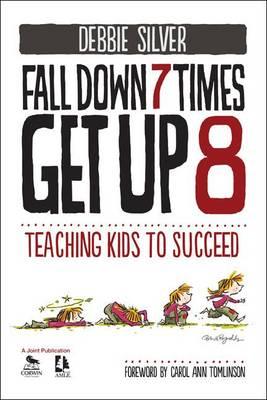What Makes Kids Tick & Learn
Fall Down 7 Times Get Up 8: Teaching Kids to Succeed
By Debbie Silver
(Corwin Press, 2012 Learn more)
We have to teach our children they have power over their lives, and through their efforts and their choices, they can affect change in their circumstances and in their destinies. We can no longer perpetuate the myth, “You can be anything in the world you want to be,” but we must constantly remind them that through purposeful practice they can get better at anything they choose. We have to show them every day that effort and choices are things they can control, and in fact, they are the keys to a successful life.” (pg. xx)
Currently a TV commercial asks, “So, what’s in your wallet?” I’d like to paraphrase this and ask, “So what books are on your professional reading list to inform your practice?”
Okay, you’re now thinking: I don’t have the time or money to add one more book to my reading list.

Bringing research into the classroom
Dr. Silver’s gift is not just in informing readers about motivational research, but in bringing all the research together for classroom application. At the end of my first day of reading, my lesson plan included informing my students about how we were engaging in “deliberate practice,” and I showed the Nike “No Excuses” ad by Michael Jordon that was suggested in the book.
Through reading books by Carol Dweck and Peter Johnston, my classroom feedback improved and now includes words/phrases such as “yet” and “what do you know already.” Debbie Silver has now added another key phrase to my repertoire. When discussing self-regulation, Dr. Silver writes: “The words ‘for now’ tell them we take note of their objections, and they also let them know the adult is ultimately the one in charge.” (pg. 44) Recently, I told a group of second graders who wanted to work on iPads first that: “This is what we are going to do for now, but your next math station will include working with our iPads.”
Providing practical solutions
Dr. Silver writes in her forward that the purpose of this book was to “synthesize the thinking of major motivational theorists into a framework of what to say and what not to say to children and why. My intent is to provide specific, applicable solutions to common encounters of adults who work with kids.” (pg. xx). I thank her for taking on this task and I appreciate the enormity of it – having read a few of the books she cites (Mindset, Drive, Outliers, Punished by Rewards, Emotional Intelligence, Teaching with the Brain in Mind, and All Kinds of Minds).
Her success is not only in synthesizing motivational research, but in the frameworks she provides. Each chapter provides scenarios, possible conversations that demonstrating various levels in applying the research, what to say when giving feedback to students, as well as modeling suggestions (negative modeling / positive modeling).
The chapters include self-motivation; zone of proximal development; self-regulation, deliberate practice and failure; attribution theory; mindset; examining rewards; autonomy, time and flow; helping students stay motivated as they get older; inspiring young children; and a FAQ section about teaching students to be successful.
The glossary provides information and background about the terms, theories, and studies that she cites. The discussion guide will help support professional conversations.
For novices, veterans – and parents!
This book is invaluable to both novice and experienced teachers. It energized my teaching, informed my pedagogy, and improved my practice. If you’re a parent or grandparent, you’ll find yourself turning back to this book for use in your personal life. What more could I ask from a book after my 30+ years of teaching?
Also see Susie Highley’s review of this book.
Julie Dermody, NBCT, is currently an ESL teacher in the Chapel Hill-Carrboro (NC) City Schools. She has also served as an elementary, middle and high school teacher, a reading specialist and a teacher of gifted students. Her article about ESL students, “Going for the Growth,” appeared in the September 2012 Educational Leadership (online edition). At MiddleWeb find her review of Minding the Achievement Gap One Classroom at a Time and her article, “From Resume to Bucket List.”


































